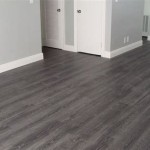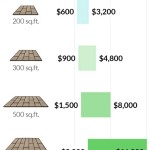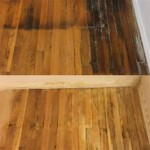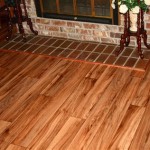How to Seal Laminate Flooring
Laminate flooring offers an affordable and aesthetically pleasing alternative to hardwood. Its multi-layered construction, typically featuring a decorative layer atop a high-density fiberboard (HDF) core, provides durability and resistance to scratches, dents, and fading. While inherently water-resistant, laminate flooring is not waterproof. Moisture penetration can lead to swelling, warping, and eventual degradation of the core. Therefore, sealing laminate flooring, particularly in moisture-prone areas like kitchens and bathrooms, can significantly extend its lifespan and maintain its appearance.
The process of sealing laminate flooring involves applying a sealant that creates a protective barrier against water and other liquids. This barrier helps prevent moisture from seeping into the seams, edges, and surface of the planks, thereby safeguarding the integrity of the flooring. Selecting the appropriate sealant and applying it correctly are critical for achieving optimal results.
Choosing the Right Sealant for Laminate Flooring
The selection of the correct sealant is paramount for effectively protecting laminate flooring. Several types of sealants are available, each with its own properties and suitability for different situations. It is imperative to choose a sealant specifically designed for laminate flooring to avoid damaging the surface or compromising its integrity. Common sealant options include:
Acrylic Sealants: Acrylic sealants are water-based and offer good adhesion to laminate surfaces. They provide a flexible and durable seal that can withstand moderate moisture exposure. Acrylic sealants are typically easy to apply and clean up, making them a popular choice for homeowners.
Silicone Sealants: Silicone sealants offer excellent water resistance and flexibility. They are particularly well-suited for sealing gaps and joints in areas with high moisture levels, such as bathrooms and kitchens. However, silicone sealants can be more challenging to apply and may require mineral spirits for cleanup.
Polyurethane Sealants: Polyurethane sealants provide superior durability and resistance to abrasion and chemicals. They form a tough and long-lasting seal that can withstand heavy foot traffic and harsh cleaning products. Polyurethane sealants are typically more expensive than acrylic or silicone sealants but offer enhanced protection.
Laminate Floor Sealers: These are specialized products formulated specifically for laminate flooring. They often contain a blend of acrylic and polyurethane resins to provide a balance of water resistance, durability, and ease of application. Laminate floor sealers are designed to penetrate the surface of the laminate and create a protective barrier without altering its appearance.
When selecting a sealant, it is crucial to consider the specific application and the level of moisture exposure expected. For areas with minimal moisture, an acrylic sealant may suffice. For high-moisture areas like bathrooms and kitchens, a silicone or polyurethane sealant is recommended. Always read the manufacturer's instructions carefully and choose a sealant that is compatible with the type of laminate flooring installed.
Preparing the Laminate Flooring for Sealing
Proper preparation is essential for ensuring that the sealant adheres correctly and provides effective protection. Before applying any sealant, the laminate flooring must be thoroughly cleaned and dried. The following steps should be taken to prepare the floor:
Cleaning: Begin by removing all furniture and objects from the area to be sealed. Sweep or vacuum the floor to remove any loose dirt, dust, and debris. Use a damp mop with a pH-neutral cleaner specifically designed for laminate flooring to clean the surface. Avoid using excessive water, as this can damage the laminate. Pay particular attention to cleaning the seams and edges of the planks, as these are the most vulnerable areas for moisture penetration.
Drying: After cleaning, allow the floor to dry completely. This may take several hours, depending on the humidity and temperature. Use fans or open windows to expedite the drying process. Ensure that there is no visible moisture on the surface of the laminate before proceeding to the next step.
Inspection: Once the floor is dry, carefully inspect it for any gaps, cracks, or damage. Address any issues before applying the sealant. Fill small gaps with a color-matched laminate filler or caulk. Repair any damaged planks or replace them if necessary. Failure to address these issues can compromise the effectiveness of the sealant and allow moisture to penetrate.
Masking: Use painter's tape to mask off any areas that should not be sealed, such as baseboards, walls, and door frames. This will help to ensure a clean and professional finish. Apply the tape carefully and firmly to create a tight seal.
By thoroughly cleaning, drying, inspecting, and masking the laminate flooring, one establishes a solid foundation for the sealant to adhere properly and provide maximum protection against moisture.
The Process of Applying Sealant to Laminate Flooring
The application of sealant to laminate flooring requires careful attention to detail to ensure a uniform and effective barrier against moisture. The specific application method will vary depending on the type of sealant used. Always refer to the manufacturer's instructions for specific guidance. Generally, the following steps are involved:
Application Method: Laminate floor sealers are typically applied with a foam applicator, a microfiber mop, or a paint pad. Pour a small amount of sealant into a paint tray or bucket. Dip the applicator into the sealant and squeeze out any excess. Apply the sealant in thin, even coats, working in the direction of the planks. Overlapping each stroke slightly to ensure complete coverage. Avoid applying too much sealant at once, as this can lead to pooling and uneven drying.
For sealants applied using a caulking gun, such as silicone or polyurethane, carefully apply a bead of sealant along the seams and edges of the planks. Use a wet finger or a sealant smoothing tool to smooth the bead and ensure a tight seal. Wipe away any excess sealant with a damp cloth. Pay particular attention to sealing around pipes, fixtures, and other potential entry points for moisture.
Number of Coats: The number of coats required will depend on the type of sealant and the level of protection desired. Most manufacturers recommend applying two coats of sealant for optimal results. Allow each coat to dry completely before applying the next. Follow the manufacturer's recommendations for drying time, as this can vary depending on the product and the environmental conditions. Drying times are typically between 2-6 hours between coats and a full 24-72 hours before heavy foot traffic is allowed.
Drying Time: Allow the sealant to dry completely before walking on the floor or replacing furniture. The drying time will vary depending on the type of sealant, the humidity, and the temperature. Refer to the manufacturer's instructions for specific drying times. Avoid placing rugs or other coverings on the floor until the sealant is fully cured.
Clean-up: Clean up any spills or excess sealant immediately with a damp cloth. For sealants that require solvents for cleanup, such as silicone or polyurethane, use mineral spirits or the recommended solvent to remove any residue. Dispose of any used applicators, cloths, and containers properly according to local regulations.
By following these steps carefully and adhering to the manufacturer's instructions, one can successfully apply sealant to laminate flooring and create a durable and effective barrier against moisture. Regular maintenance and cleaning will further extend the lifespan and appearance of the sealed laminate flooring.
While sealing laminate flooring can provide added protection against moisture damage, it is important to understand the limitations. Laminate flooring is not inherently waterproof, and excessive exposure to water can still cause damage. Regular cleaning and maintenance are essential for maintaining the integrity of the flooring and preventing moisture penetration.
By carefully selecting the appropriate sealant, preparing the floor properly, and applying the sealant correctly, homeowners can significantly extend the lifespan of their laminate flooring and enjoy its beauty and durability for years to come. Regular inspection and maintenance will help to identify and address any potential issues before they lead to significant damage.

Laminate Flooring Seal Pros Cons And How To

Floor Coating And Sealing Of Resilient Floors With Pu Sealer

How To Seal Laminate Flooring Seams A Diy Project The Lady

How To Seal Laminate Flooring Seams A Diy Project The Lady

Laminate Flooring Seal Pros Cons And How To

Floor Coating And Sealing Of Resilient Floors With Pu Sealer

Learn The Secrets To Sealing Laminate Floors Ko Fi Where Creators Get Support From Fans Through Donations Memberships S And More Original Buy Me A Coffee Page

Laminate Flooring Seal Pros Cons And How To

Home Repair How To Seal Laminate Flooring Expansion Gaps Diy Family Handyman

This Is How To Seal Laminate Flooring The Right Way
Related Posts








